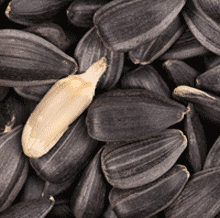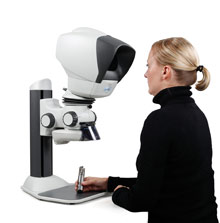Great Britain’s Royal Botanic Kew Gardens Millennium Seed Bank saved many wild plants from extinction by conserving their seed in deep freeze. To effectively monitor and perform research into seed health during storage, Kew Gardens used a pair of high power Lynx stereo microscopes
Long term plan to save the seed
The destruction of natural environments around the world is often so fast that it is impossible to conserve unique species of plant in their natural habitats. The only effective way to save them is by storing a quantity of their seed in a seed bank.

The Millennium Seed Bank aims to collect seeds from all of the UK’s 1,400 native plants which have storable seed, making it the largest seed bank in the world. They also aim to collect seeds from 10% of the world’s entire storable plant material, amounting to around 25,000 different species.
At the time seed banking was, however, a relatively new science, and detailed research was still needed into seed banking techniques. As part of this, Kew purchased two Lynx stereo microscopes from Vision Engineering.

The scope allows users to be up to 31cm away during the viewing, which combined with the angular flexibility, offers an exceptional freedom of head movement and comfort because operators are encouraged to sit in a correct upright position when using the instrument. The expanded Pupil technology even allows users to wear glasses or contact lenses.
When having to inspect the seeds on a day to day basis, comfort and posture is key, with the Lynx optimising ergonomics, it allows users to stay focused for longer, increasing productivity.
We do a lot of microscopy work which by its nature can be very tedious and monotonous, but the Lynx makes it a lot easier on the users because they can maintain a really comfortable posture.”
Lynx microscope proves to be a valued research tool
For seeds to be prepared for storage in the Seed Bank, they are first dried in an insulated drying room (kept at 15°C and 15% relative humidity), cleaned to remove any unwanted material, tested to make sure they are healthy enough to germinate, and finally put into airtight containers before being stored in deep freeze at -20°C.
“The standard way of checking their ability is to germinate them,” continues Manger. “If a seed germinates, you know its batch is fine. Although some seeds that don’t germinate may not be dead, but what is known as dormant. We then cut the seed and stain it using a viability stain.”
When we then look at it – now under the Lynx – if it’s still alive and healthy it will stay red in colour. Alternatively, if it has died or is infected, we might want to examine it and find out why, for example due to infestation by beetles or insects.”
“The Lynx is also a very useful research tool when carrying out experiments on seeds. Most seeds are very small, on average measuring between 1-3mm in size. It is therefore much easier to manipulate and cut them under a microscope. For example, an Orchid seed is tinier than dust and you have to use a microscope to examine it because it’s typically up to 1mm long, but only 0.5mm wide, with the actual embryo inside being only 30% of that area, or 30 microns in size.”
Botanic seed storage
Stored seeds are also vital to other scientific research fields such as pharmaceuticals, where new life saving drugs could not be developed if a species they would rely on had been allowed to die out, or samples weren’t easily obtainable from the Seed Bank.
One collection of stored seed at Wakehurst, for example, was made from a collection of a Mediterranean species that ended up yielding a blood-clotting protein that is now being used to detect rare human blood disorders.
Some seeds however can’t be stored because they will die when dried and frozen, an acorn from an oak tree being an example of this. It is also believed that the seeds of most tropical rain forest trees won’t withstand this treatment either. So research is now also being conducted at Wakehurst to find alternative ways of storing these seed types in the long term.
Lynx has it all
Another advantage of the Lynx microscope in such research is that it is based around a flexible modular design and has an extended magnification range that suits the needs of research institutions like Wakehurst.
“Usually, laboratories have a very fixed need,” continues Manger. “But when you’re a research laboratory that need changes week on week, month on month, because you never know in which direction your research is going to take you. So you need equipment that will be flexible. If you need increased magnification, for example, you don’t want to have to dump half your existing equipment and buy new, you want to be able to adapt what you’ve already got.”
While your standard stereo microscope will go up to about 40x, the Lynx is capable of going up to a very high magnification of 160x. Most stereoscopes also require a separate light source, but the Lynx has a built-in light source which again means less cables and less fuss when using it.
Future plans
Kew is considering many other uses of the Lynx including its ability to work in conjunction with computers to digitally export images for analysis and manipulation.
“This would save us a lot of hard work and images and information from the scope could then be stored for future reference. We also envisage having CCTV cameras on one of the microscopes and having it displayed up to the public so that they can see what we’re doing all the time. The instrument could also be used to take still photographs for publication purposes.”
The Lynx makes seeds easily and rapidly available for research and investigation, and hopefully new leading edge laboratory tools, like the Lynx, will continue to make this vital endeavour easier and more effective.



